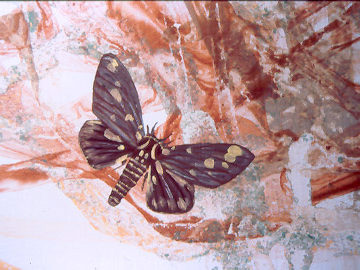Archive
Mario Perez Between Earth and Sky
Artist Statement by Bill Davenport
Mario Perez’ paintings are a mess. Streaks, blots and gushes of liquid paint fill each square canvas to bursting. Unsavory sediments pool and crust over, and transparent rivers of color creep and swirl to form thickets, jungles or cesspools inhabited by neatly rendered textbook birds and insects. InCutie, a chubby cartoon girl in an apron points a finger of shame at a network of multicolor stains as if scolding the artist. He¹s guilty: part of the visceral delight Perez takes in pouring paint across clean canvasses is its naughtiness.
Perez¹ paintscapes are lush, mysterious or toxic by turns. In one, a lone blackbird crouches in a verdant marsh of watery green smears and tangled brown drips; in another, cancerous tar-colored smudges hide a flock of dark birds, as if they were perched inside smoker¹s lung. Dragonflies flitting across one vast canvas suggest a misty pond while the spatterings behind them could be a grungy wall or dirty linen, depending.
Perez¹ splashes, however messy, are never careless. They travel from right to left, up and down, or corner to corner with half-controlled purposefulness, carefully coached to run slower, faster, left, right, forward or back at Perez¹ direction. His low-key, hands-off technique is more like the stain paintings of Morris Louis or Helen Frankenthaler than the assertive paint flinging of Jackson Pollock, but it¹s even closer to the making of marbled paper. Like Da Vinci, Poussin, and other artists throughout history, Perez interprets random paint smudges as landscape, using hidden creatures to make this metaphor laughably literal, negating the pretensions of high abstraction with a light hearted playfulness free of the heavy-handed irony which characterizes much contemporary painting.
If Perez¹ freeform sloshes recall high art, his bugs and birds have an intentional stiffness drawn from the deadpan illustrations in vintage nature guides. Word paintings like Chuck Roast and Pork Chop draw heavily on the surreal, garish vernacular ofMexican sign painting. Poised between high art and low culture, Perez combines the innocent enthusiasm of folk art with an educated command of history. It is this tension between high and low, faux-finishing and high abstraction, concrete poetry and tacky signage that makes Perez¹ paintings a treat.


